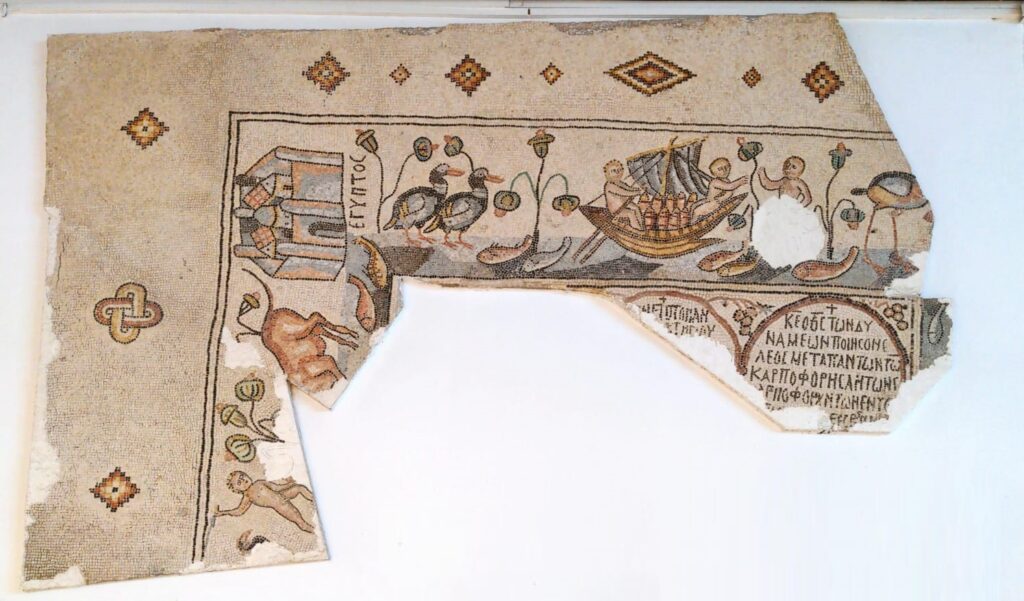Tel Hadid is located south of Nahal Natuf, a tributary of Nahal Ayalon. Its location is on the border between the Samaria Mountains and the Lod Valley to the west. This place has been an important crossroads throughout history. Near the site passed the “Via Maris“, connecting Syria and Egypt. Several roads also passed in the area, connecting the port in Jaffa to the city of Jerusalem. Today this area is part of the Ben Shemen forest, near the Ben Shemen interchange. On the site is the Arab village of al-Hadita, which preserved the name “Hadid” from the biblical and Hasmonean times. The most important find at Tel Hadid is two inscriptions documenting a real estate transaction of Babylonian exiles who settled there during the reign of the Assyrian Empire in the 7th century BC. According to the Book of Maccabees 1, there was a Hasmonean fortress in Hadid, the remains of which are visible today on top of the mound.
Research history
Already in the Middle Ages, Rabbi Ishtori Haparhi identified Haditha with biblical Hadid. The site was visited by European researchers in the 19th century and in the 40s a mosaic floor from the Byzantine period was excavated. Salvage excavations were conducted at the site by the Antiquities Authority and the most extensive was in the 1990s on behalf of Tel Aviv University, under the management of Ester Brand and towards the construction of Highway 6 that passes by the mound. This excavation revealed the Assyrian inscriptions. In 2018, a joint expedition of Tel Aviv University and the New Orleans Baptist Theological Seminary, led by Ido Koch and Jim Parker (respectively), began to investigate the site.
The beginning of the settlement in Hadid and the period of the Kingdom of Israel
Until the biblical period, there is very little evidence of settlements from the Intermediate Bronze (2500-2000 BC) and final stages of the Late Bronze Age (13th- 12th centuries BC). During the Iron Age 2 period (8th-10th centuries BC) Hadid was one of the southernmost settlements of the Kingdom of Israel, near the cities of Gezer and Lod. Very little of the settlement was uncovered in the excavations. Many pottery vessels were discovered at the site, as well as the remains of buildings. Near the mound, a pit was discovered in which cultic vessels were stored, including chalices and a donkey figurine dating from around the 9th century BC. It seems that the site hosted trade relations between Israel and Judah.
Hadid under Assyrian, Persian, and Hasmonean rule
The settlement continued and even flourished after the Assyrian conquest of Israel. A find that may explain the reason for this is two inscriptions on clay tablets written in cuneiform. This script has not been used in Israel since the 12th century BC. One of the inscriptions is from the fall of 698 BC and it indicates a transaction in which a man named ” Marduk-bela-usur” purchased a field from a man named ” Aya-shebshi”. According to Assyrian and Babylonian custom, the transaction was made in front of seven witnesses. The second inscription is from the spring of 664 BCE. The names that appear in it are Babylonian and Aramaic, which indicates that these are exiles brought to Israel by the Assyrians. A similar example was also discovered from Tel Gezer during this period, and it is known that the Assyrians established settlements along the sea route. Many olive presses were found at the site, and it seems that Hadid was involved in the oil industry. It is therefore interesting that the olive presses are in the Israelite style, even though the population that used them was apparently of foreign origin.
According to the books Ezra and Nehemiah, during the reign of the Achaemenid Empire, Judahites who returned from exile in Babylon settled in Hadid. According to the book of Maccabees 1, Shimon the Maccabee fortified Hadid during his war against the Seleucid king Tryphon, and the battle between them took place in the valley below the site. The Jewish-Roman historian Josephus Flavius reported that General Vespasian (later Roman Emperor) fortified Hadid to block the road to Jerusalem during the Great Revolt. The remains of a large building, possibly a citadel, dating back to the Hasmonean period (1st-2nd centuries BC) were indeed discovered at Tel Hadid and various finds from the Roman period were also discovered.
The later periods on the site
The settlement in Hadid reached its peak in the Byzantine period. During this period, most of the country was Christian. Hadid appears as a church called “Adida” on the Madaba map from the 6th century AD. A mosaic floor was discovered on the site which probably belonged to a monastery or a church that was there (today the floor is displayed in the Haifa Museum). The mosaic includes images of the Nile River. During this period, a large winepress operated there. The findings include many vessels, ceramic lamps, glassware, jewelry and a silver cross.

Mosaic from Tel Hadid (Source)
The settlement at the site continued to exist intermittently during the Islamic periods. During the Ottoman period, there was an Arab-Muslim village called “Hadita” in Tel Hadid, which was the closest village to the Jewish Ben-Sheman boarding school, and where there were many olive groves. The village existed until 1948. In 1949-1950, a kibbutz named “Tehiya” was briefly settled here. After that, Jewish immigrants from Yemen settled in the place, and then established the nearby Moshav Hadid. Today Tel Hadid is a tourist site, part of the Ben-Sheman forest.
Sources:
- Torgë, H. 2016. Tel Hadid: Extended Report. Hadashot Arkheologiyot 126.
- Koch, I., Yannai, E., Werner, D. 2021. Tel Hadid – 2018, 2019: Preliminary Report. Hadashot Arkheologiyot 133
- Koch, I., et al. 2020. Forced Resettlement and Immigration at Tel Hadid. Biblical Archaeology Review 46/3: 28–37


